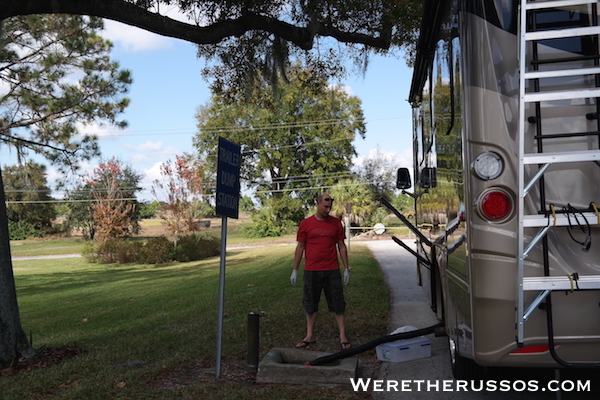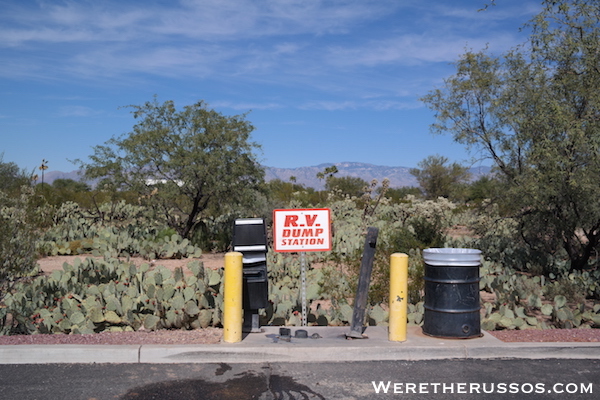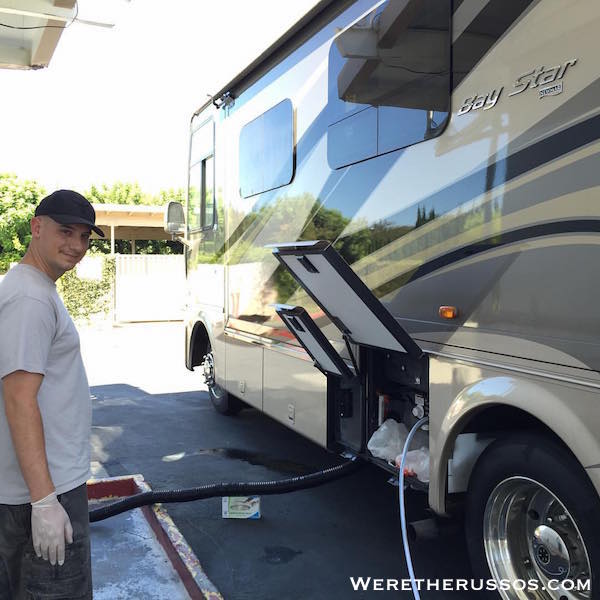This post may contain affiliate links.
For first time RVers, the idea of dumping the black tank and gray tank can seem like a daunting and perhaps even disgusting task. I remember all the research I did on how to dump RV tanks before Kait and I hit the road in 2015 and some of the horror stories made us want to avoid the black tank all together. However, I learned that RV dumping isn’t so bad once you get the process down and have the right gear. So here are my tips on how to dump RV tanks and where to find RV dump stations.

Tips on How to Dump RV Tanks
Keep in mind that these tips were originally created for our first RV which was a small Class A motorhome under 30 feet. The size of the black tank and gray tank, the gear and process for dumping the RV waste are based on the specs of that camper.
We have lived out of other types of campers since then from a small Class C RV to different Class B RVs with only a gray holding tank and now a pop top truck camper with a portable toilet.
Whether you have a traditional RV waste tank setup or a portable waste tank, these tips on how to dump RV tanks will still be helpful to know.
1. Use the 2/3 Rule
Once we hit the 2/3 full mark on our 40 gallon black tank we start to plan for our next dump. Our 60 gallon gray tank never reaches 2/3 before our black tank which is why we go by the black tank indicator.
The reason we use the 2/3 mark is to avoid over filling the tank and to allow enough time to find our next RV dumping station. When you’re camping in the national forest, a RV dump isn’t always easily accessible and it’s good to plan ahead, especially if you prefer to find free RV dump stations like we do (more on that below).
2. Level the RV Before Dumping
Many RV dump stations we’ve pulled into are on uneven pavement and we’ve been to a lot of them since hitting the road full time in 2015. If it’s uneven to the point where we won’t be able to empty our tanks because of the angle, we will put the jacks down and level the RV enough to be able to empty the tanks.
When we downsized to a Class B RV on the ProMaster chassis, we did not have jacks and used a set of rubber leveling pads when dumping the gray holding tank. Want to learn more about what we did with our black waste? Read our post on the cassette toilet and where to dump it.
3. Close the Windows
Avoid having your camper smell like the RV dump station by closing all the windows and turning off the fans. While Joe was getting set up to dump the holding tanks, I would work on closing the windows and vents.
4. Have Gloves and Disinfecting Wipes
We always have a good pair of disposable gloves and disinfecting wipes in the camper for dumping the holding tanks. Keep these in a place that’s easily accessible and have them ready before you start dumping.
There are reusable rubber gloves and heavy duty disposable gloves that can be used for RV dumping. It may take testing out a few different pairs before finding the best RV dumping gloves for you.
When we had the storage space in our first RV, we would buy the three pack of disinfecting wipes at Costco. Now that we’re in a smaller camper with limited storage, we buy the disinfecting wipes one at a time.
5. Have a Good RV Sewer Hose
When it’s comes to connecting all the gear to dump the tanks, you want to make sure you have a good RV sewer hose. We use the Valterra Dominator Hose along with a Camco RhinoFlex Clear Elbow attachment for it in order to see what’s coming out of the tanks.
There are sewer hose support systems to help keep things flowing smoothly, but we never found a need for it. Part of that is because we were constantly on the move. A support system makes sense if we stayed at campgrounds with full hookups for an extended amount of time.
Make sure all connections are secure before moving on. A family friend had an incorrect fitting that lead to a black tank spill in the wet bay that was not fun to clean up.
6. Use a Twist-On Waste Valve
Joe installed the Valterra Twist-On Waste Valve on our first RV and in our truck camper. If you don’t have a gate valve, we highly recommend it to prevent spills when you open the cap and to serve as a second gate in case your black or gray tank valve starts to leak.
7. Dump the Black Tank First
Since our first RV had a black and gray tank, the black holding tank was dumped first. Then we sprayed down the black tank by connecting the non-potable water hose to the black tank sprayer system. Once the black tank is empty, turn on the sprayer and spray until the water runs clear (another benefits of having the clear elbow).
If you don’t have a sprayer in the black tank, bring a hose into the RV and spray it down the toilet after the black tank is emptied. Alternatively, you can fill a 5 gallon bucket with water and pour it down the toilet.
Close the black tank valve and disconnect the water hose from sprayer system or keep this connected to the spigot if you want to spray down the sewer hose at the end.
8. Dump the Gray Tank Second
Open the gray tank valve and the gray water will help clean out the black tank residue in the sewer hose. Once the gray tank is emptied, close the gray tank valve. Allow all the water to drain before closing the gate valve.
9. Spray the Sewer Hose
Use the non-potable water hose to spray down the sewer hose while it’s still connected to the sewer. Be very careful not to splash yourself while doing this.
Drain remaining liquids into the sewer and disconnect the hose from the sewer. Use disinfecting wipes to clean the ends of the hose. In the Class A RV, we stored sewer hose in large container inside the wet bay.
10. Put Everything Away
It goes without saying that you’ll want to put everything away before you pull away from the dump station. Make a checklist if it helps you remember. We have pulled into many dumps stations where people left items behind.
11. Treat the Holding Tanks
There are many products out on the market to treat the black and gray tanks. We used this organic RV holding tank treatment in the Class A RV.
The Bag of Ice Trick
After dumping the tanks, some people will pour a bag of ice down their RV toilet so it can slosh around the black tank as they drive and scrape off anything stuck to the inside. We tried this once after a dump and found it to be more trouble than it was worth. The sprayer system in the black tank did a good job of cleaning everything out.
Dumping at a Full Hookup Site
When we were camped at a full hookup site, we connected the water and electric, but often times left the sewer disconnected until it was time to dump. If we did connect the sewer, all the valves remained closed until we were ready to dump. Although you can leave the gray tank valve open, we left ours closed to prevent critters and odors from getting in through the hose.
The black valve should remain closed until you’re ready to dump – otherwise you end up with a “poop pyramid” because all the liquid will drain out while the solids build up and make the coach smell like “eew” de toilette.
How to Find RV Dump Stations

There are free RV dumps and those that charge a fee. Our favorite way to find dumping stations is through Allstays. Use the “RV Dumps” filter to find the an RV dump near you. Read our review to find out why Allstays is a must have app for RVers.
Finding an RV Dump Station
There RV dump stations located throughout the United States and we’ve never had a problem locating one to dump the tanks. Popular spots that have RV dump stations include:
- RV Parks and Resorts – cost to use the dump is included with your nightly rate. If you’re not staying at the park or resort, call to find out their flat fee to use the RV dump.
- National Park campgrounds – campgrounds that can accommodate RVs will usually have an RV dump, but not always. You can check the NPS website for that campground to see if an RV dump is available. Sometimes these RV dumps are free to use even if you are not staying at the campground.
- Truck stops and gas stations – most truck stops and gas stations charge a fee to use the RV dump and it can range from a few dollars to $30 or more.
- RV Dealers and Supply Stores – local RV dealerships with service centers and supply shops may have an RV dump. Give them a call to find out. We’ve used several of these RV dumps and they have all been free.
- Cabela’s – many Cabela’s and Bass Bro locations have a SaniDump where you pay a fee or get a code from the cashier at checkout.
RV dumps that charge a fee may have a lock on the sewer hole and you will need to pay the fee first in order to unlock it.
Finding Free Dumping Stations
To find a free dumping station near by, open Allstays, filter by “RV Dumps” and zoom to the map area of your choice. Open each dump station result to read the location details which will include information on whether it’s a free RV dump, where the RV dump is located and whether potable water is available at the RV fill station.
Now, free dumping stations range from nice to “yikes – I better put on my work boots and heavy gloves”. Some of the nicest free dumps we’ve used have been at welcome centers.
Not every RV dump station will have potable and non-potable water and some only have a sewer connection. If you need potable water, call ahead to ask if they have any and whether they’ll allow you to fill your fresh water holding tank. We’ve found that most free RV dump stations have non-potable water.
Our RV Dumping Experience

Before we started full time RV living we were used to traditional house toilets where everything is flushed down never to be seen again. Then we started all our RV research and one of the big questions was how to dump the RV tanks? It was hard to imagine coming face to face with all the waste a week later – and the internet is no help.
When you search for RV dumping articles, you’ll like come across countless horror stories that will give you nightmares and make you wonder why you ever wanted to RV. Heck, a few of those stories scared us so much we only wanted to use a composting toilet in our first RV. In fact, we were dead set on it and I even convinced Joe to build a composting toilet. If you want to learn more about toilet options, read our RV toilet guide.
Why were we so afraid to dump? Fear of the unknown. Having never RVed before, our only point of reference was from the videos we watched along with the articles and forum threads we read. The only RVing friends we had at the time used a composting toilet and based on their bad experiences with traditional RV toilets and at dump stations, we were convince a composting toilet was the way to go. Sure, we would still need to go dump the gray tank, but we figured that wouldn’t be nearly as bad as having to dump a black tank.
I’ll never forget our first dump station experience. After spending $30 to dump the RV tanks at a gas station in Los Angeles, Joe and I looked at each other and said “that’s wasn’t so bad!” Sure it smelled a bit and watching the waste go through the clear elbow of the hose for the first time was strange, but our uneventful dumping experience gave us a good laugh.
We couldn’t believe we put ourselves through two weeks with a bucket toilet to find out that RV dumping wasn’t nearly as bad as we thought. It helped that we had the right gear (see tips above).
I did dump the Class A motorhome all by myself and found it to be easy and not a complicated mess like I imagined. For the record, Joe did 99.99% of the dumping in our Class A days.
Thinking about which portable toilet is best for your RV? See Best Portable Camping Toilets for Vans, Cars, and RVs.
Thanks for reading! Feel free to share your dumping experiences or tips below.

One of the best ways to double-check your connections is to let the gray tank dump for 5-10 seconds first. Then go ahead and dump the black tank. That way any ‘surprises’ are a little less unpleasant.
Also we’re now in our 6th year of camping I find that if I’m using an effective black tank treatment system, I don’t feel compelled to do a full black tank rinse every time we dump. Maybe once a month is fine if putting enough water into the black tank and we’re also spending time driving so things have a chance to agitate and break down.
Short of overfilling the black tank, the more water in there the better the system works. We put our rinse water for doing dishes into a tub, and that goes into our black tank at the end of clean up.
Thanks for the info, as I am a 1st timer getting ready to hit the road and know nothing. I lost my husband in May last year so these road trips are in his honor! Very scared what to expect dumping etc. Still have yet to purchase the needed hoses etc, any ideas etc are welcome Thanks Debbie
This subject always seems to be a real taboo thing to talk about. I am much more comfortable with what to expect. We want to rent an RV for a trip this summer and didn’t really understand. I hope that the sewer dump hatch https://westechequipment.com/product/rv-dump-station-lid?cPath=1_60_3209& will be wide enough for the hose that comes with the RV. Are the hoses a standard size so that they fit at most dump stations?
Hey Caleb!
Yep, the sewer hoses (at least in the US) are all standard so you shouldn’t have a problem. I’ve seen rentals that just come with the hose, but no 90 degree elbow at the end…this makes dumping a bit harder and some campgrounds require you to have the elbow. If you don’t, they typically sell them in the campground office or swing by a Walmart or Camping World if you need it.
Thanks so much for the article! I just ordered the twist on Valterra valve. It’s just what I needed. Appreciate all the great content you two post!
You’re welcome Tom. Glad you are enjoying the content. Happy trails.
Hi Kait,
Thanks for mentioning the Happy Campers holding tank treatment in your post; which btw was great!!! I just wanted to update you that the Happy Campers product is currently in transitioning seller accounts on Amazon and during that time can be purchased online here: http://www.rvodorfree.com/shop/
We’re working to get back up and running on Amazon as quickly as possible.
Thanks!
Hey Chris! Thanks for the product update.
Poop pyramid….I love it. I can’t tell you how many first timers that don’t understand “poop doesn’t run down hill”!
? No it doesn’t.
We’ve used the bag of ice trick, and the level sensors in the tank didn’t get clogged. This, of course, proves nothing.
Joe – Have you thought of buying a 4″ black PVC pipe which should be wider than the 3″ slinky then tying or attaching it underneath the coach near the wetbay then you can then just slide the slinky into the attached pipe and pop in the cap and use a wing nut so that the cap does not come off.
We did but found that the Newmar actually has a 4″ pipe integrated into the wet bay but our Dominator Hose is too wide – plus we’d still need a plastic container for the elbows and fittings. I have seen the PVC setups you’re talking about and they work great if you have the smaller hose.
Great article… I would recommend that you get a sewer hose support and a tapered sewer hose seal. We have been to campgrounds that require one or the other or both. Some local laws require the support I have heard and you can be fined without one. Now whether that is ever ticketed or not I do not know but I don’t want to find out.
I use food service gloves myself as they are very inexpensive compared to their counterparts. I think I paid less than 10.00 for 500 gloves. James at “The Fit RV” video blog does a great job with showing what different ways of flushing a tank accomplishes including the ice trick.
Again thanks for another great article and happy camping.
Thanks Rick. We’ve never seen any city ordinances regarding dumping but have seen rules posted at campgrounds. We do have a tapered end that can be screwed into the sewer. We don’t have the support because we use the container that we store the hose in and typically we will dump and then put the hose away because we don’t stay anywhere long enough to justify keeping it attached.
Great detail. For not yet RVers, is very informative. It isn’t something that bothers me, except to make sure when you secure the fitting to the dump connector, it doesn’t come loose. That is another one of my nightmares, that the dump,hose connector comes loose and then flying all around like a hose sprayer does when it gets lose. Got the biggest kick out of your composting toilet blog. Agree that a composting toilet isn’t worth the bother. We are going to go all electric and are not interested in boondocketing for any length of time. Have you done a blog detailing how you choose your RV and why a Newmar (I have reed all of them, I believe)? We will be full timers and a bit worried about anything smaller than a 43′ to 45′ length.
John, we did write a post about just that: https://weretherussos.com/we-bought-a-rv-2015-newmar-bay-star-2903/
We were in the same boat as you and told ourselves we needed at least 40′ to live in. We’re so happy that friends convinced us otherwise and now our 30′ feels huge. Of course it’s all a personal preference but if you’ll be moving a lot, you’ll start to get jealous of the people in the smaller rigs.
I’ve heard your same nightmare about the sewer hose. Since it’s not pressurized and the tank simply drains, there is no force to make the hose come out of the sewer connection. The weight of the liquid inside the hose will hold it down. The only time you have to really worry is if you over stretch the line and the weight of all the liquids pulls the hose down and out of the sewer.